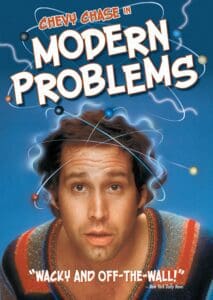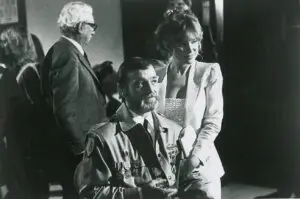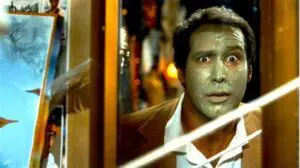Modern Problems
"A broken-hearted man + amazing moving powers = Out-of-control fun."
(1981)
starring Chevy Chase, Patti D'Arbanville, and Mary Kay Place
PODCAST:
'80s Movies: A Guide to What's Wrong with Your Parents -
MODERN PROBLEMS:
How an off-the-rails comedy is really a statement on the OG crisis of masculinity.

Max Fielder's is depressed after his bouts of jealousy led his girlfriend to leave him. But, after getting splashed with nuclear waste, it gives him powers that might just save his relationship.
Why it’s rad:
Creators Ken Shapiro and Doug Kenney were two of the strongest influencers on '80s comedy.
This is the weirdest, off the rails, yet successful Christmas movie of all time.
So '80s:
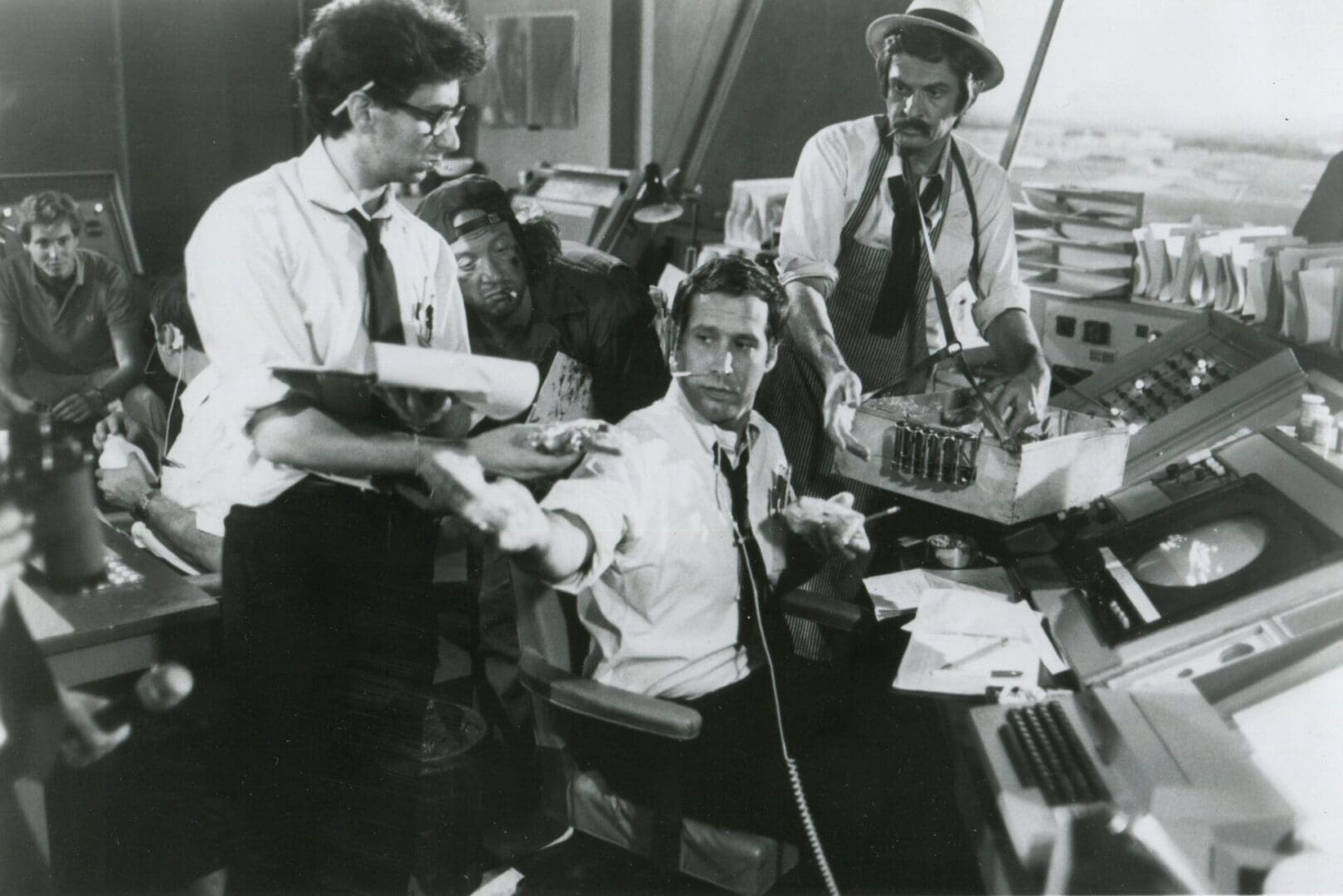
Air traffic controllers. We don't hear much about air traffic controllers these days, but they were in the news a lot in 1981. Air travel became more popular and frequent in the 1960s and 70s, creating a more stressful work environment and conditions in the tower. After forming the Professional Air Traffic Controllers Organization in 1968, the union made their presence known. To protest work conditions, they staged sickouts and organized work slowdowns -- causing mass flight delays, cancellations, and utter chaos. It was all coming to a head when PATCO announced a strike in August 1981. The strike and President Reagan's subsequent controversial firing of more than 11,000 air traffic controllers was occurring while Modern Problems was filming. There was a severe shortage of air traffic controllers, which was crippling the airline industry at the time of Modern Problems release, so that Max's miserable job served as its own punchline.
Cassette tapes. Sure, In his 1981 Lancia Beta Coupé, Max has a couple of issues: the convertible top won't close and his cassette player eats his mixtape. In 1981, cassette players had become more popular than 8-tracks. The next year, 8-tracks would be phased out. And, it's also historically accurate that your car player would eat your tapes.
Toxic waste. Hazardous waste disposal became a huge focal point for American following the Love Canal environmental disaster of 1977. In 1979, Three Mile Island nuclear plant had a radiation leak that also caused widespread concern and grabbed headlines. In 1980, Congress passed the Superfund Act to deal with containing and cleaning up toxic chemicals. This was another issue on the mind of the American public in 1981, and they'd totally get the joke of a truck recklessly splashing toxic sludge onto other vehicles.
Telekinesis. A public fascination with the purported ability to move objects with one's mind had been building for the last century. In the 1970s, the ideas of psychic powers and ESP were truly thought possible. Uri Geller, a man who would bend spoons without touching them, was in his hey day. Colleges and the military were spending millions to research parapsychology, as demonstrated in Ghostbusters. It was becoming a popular notion to explore in films, such as Carrie and Star Wars.
Voodoo. In 1980, a Haitian man who'd been pronounced dead and was buried 18 years prior showed up in his village. He claimed he'd been pulled from his grave and turned into a zombie as a result of Voodoo powders. What's crazier is that this story appears to be pretty accurate, which ginned up interest in VooDoo and the occult.
What’s your damage?
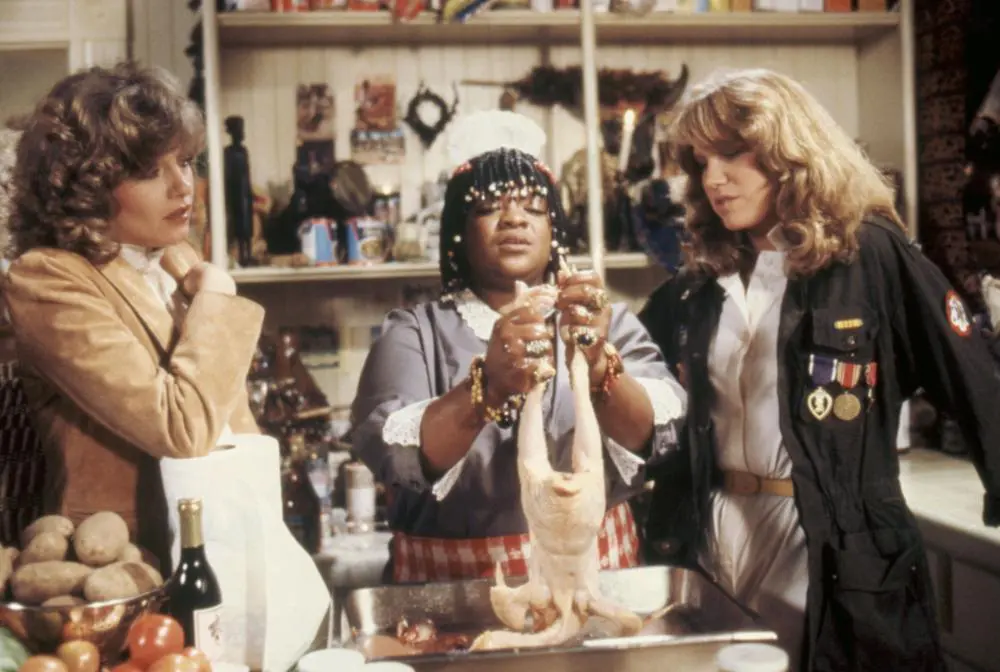
Modern Problems is full of what we'd now see as mixed messages. Moving the ball forward on progressive issues of the day while simultaneously running it back.
ONE STEP FORWARD: Max is a modern man trying to figure out where he fits into the new scheme of gender relations. The film is arguably about figuring out what it means to be man in this sort of new world order where married couples divorce but are still best friends and girlfriends now have jobs where they entertain male clients late into the night -- just like men. Men had to make an abrupt pivot but aren't allowed to be upset by it. Additionally, we still live in an era where "real men" didn't talk about their feelings, so all of these emotions are inside, bubbling and occasionally emerging in socially unacceptable ways. Chevy Chase described his character like this: "Max Fielder is basically a nice guy who suffers from most of the hang-ups of our society. He's jealous, possessive, uptight, and insecure. But he can't verbalize those feelings, so he's got a lot of repressed rage."
TWO STEPS BACK: Women exist only as sexual objects and support devices for Max. Lorraine is Max's ex-wife, but what does she do? She meets him for a bike ride and a soda while hearing about his latest girlfriend woes -- during which, she teases him that she may want to have sex with him. When she meets his friend Brian, she's instantly attracted and by the next day, Brian tells Max they had sex. Darcy is Max's love and we understand she has a job as a fashion buyer -- and even briefly see her at her workplace -- but what else do we know about her? She exists as the love interest for Max to pine over, win over, give him comfort and self-assurance. What does Darcy get out of her relationship with Max?
ONE STEP FOWARD: Brian Stills is popular, successful, rich, and sexually attractive. And, in a wheelchair. Characters with disabilities are rarely in film. If they are, they're often someone to pity or a villain. There was no reason, storywise, this character had to have a handicap, but there quite a few who returned from Vietnam in wheelchairs. Modern Problems should be noted for its positive inclusivity by creating an aspirational male supporting character as someone with a physical disability. The characters acknowledge his disability, while also demonstrating isn't stopping him in any way from living life to the fullest.
TWO STEPS BACK: Brian is also a pedophile. Upon meeting Lorraine, Brian explains why he's lost the use of his legs: "I got my ass blown off in Nam. Crazy damn thing. I was loving this little girl. She was hiding ammo, for the Cong under the bed. I lit a cigarette, woke up in the hospital with medals all over the place." Wait. WHAT??? "LITTLE GIRL?" Is there ever a reason to call an adult woman who is old enough to consent "little girl??" Just in case there was a misunderstanding, Lorraine jokes, "God, talk about sex with fireworks?" and they all laugh. So. Yeah. Having sex with a minor. So...is it supposed to be okay because the little girl was Vietnamese? So now, the favorable portrayal of a vet with a disability is apparently also a sex offender when it suits him.
ONE STEP FORWARD: A woman of color is cast in a substantial comedic role. If anyone should get second billing to Chevy Chase, it's Nell Carter. The more we see her, the funnier the movie gets. While Richard Pryor and Eddie Murphy were among the biggest movie stars. A comedic actress of color getting a substantial supporting role in a major studio release in 1981 was rare.
TWO STEPS BACK: However, the only character of color is a servant who practices VooDoo. Given that the storyline goes to VooDoo, it may have been insulting to have a white character be from Haiti - so we'll give the writers that. But, couldn't there have been another central character of color who is NOT a servant painted as being "out there" in her beliefs?
Behind the Scenes
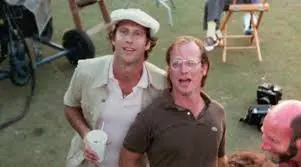
CONCEPTION TO PRODUCTION
Doug Kenney's agent put him in a production partnership for his own good. The Animal House writer-producer and National Lampoon founder was considered one of the great comedic geniuses of the time. However, his agent recognized that Kenney was a creative who needed some guidance. Producer Michael Shamberg said in the book "That's Not Funny, That's Sick," that the agent put them together because Kenney needed "some down-to-earth people to manage his ideas." Shamberg and his production partner Alan Greisman formed Three Wheel Productions with Kenney.
The trio start assembling projects. While Kenney was making Caddyshack, Shamberg and Greisman got to work, assembling projects. First up: Club Sandwich, a Club Med parody written by Kenney's Animal House co-writer, Chris Miller. That film as eventually completed and released in 1986, retitled Club Paradise and starred Robin Williams and pal Brian Doyle-Murray. Additionally, they began working on a Jules Pfeiffer-scripted film about a young mayor based on Dennis Kucinich.
The group create a project based on personnel but without a story. Three Wheel struck a deal with Ken Shapiro to direct a film. Shapiro calls on the movie star that he and Kenney both enjoyed working with: Chevy Chase. In the late 1950s, Chase co-founded the sketch comedy troupe Channel One with Ken Shapiro, which became a TV program airing in New York City. In 1973, Chase was also a member of the Harvard Lampoon stage show, "The Lemmings."as well as "The National Lampoon Radio Hour" -- both overseen by Kenney. A year later, Chase and Shapiro made their first film together, the highly influential The Groove Tube, which satirized media. Shapiro's two projects were the inspiration for Saturday Night (later Saturday Night Live). So, the three were all friends and co-conspirators in changing the world of comedy and satire.
"Teen-Age Communists from Outer Space." Kenney had a title but no story -- and there appears to be a reason for this. In National Lampoon's second year of publication, Kenney famously disappeared for a year to write a novel. When he returned to the offices, he gave the manuscript to colleagues and friends. In 1985's "The Doug Issue" of National Lampoon, Matty Simmons recounts the incident: "I read it. When he came back I did what we always did when we dealt with each other I told him the truth. I said it was lousy. He nodded, picked up the manuscript, and underhanded the entire sheaf of papers into my wastebasket. 'Yeah,' he said. "Henry [Beard] thinks it stinks, too. The next day he was back on the job; no mention of the missing year or the manuscript that he'd worked on for that year or why he'd left without talking to us first." The title of the comic novel: "Teenage Commies from Outer Space."
Telekinesis brings Modern Problems down to earth. Shamberg told The New York Times that they didn't have a story until Shapiro had "this blinding stroke.'' Chase, in the same interview, added, ''[Shapiro] said, 'Telekinesis, telekinesis, I know there's something funny in watching people make objects fly around.'" Old issues of National Lampoon indicate that telekinesis was a subject they thought was ripe for humor.
Modern Problems is announced as Three Wheel's first film to go into production. On Jan. 25, 1980, both Daily Variety and The Hollywood Reporter state that 20th Century Fox will make Modern Problems as the first of several films.
The SAG strike throws a wrench into the schedule. The SAG actors strike began July 1, 1980. Chase was committed to filming the comedy Under the Rainbow before Modern Problems, delaying the start of principal photography for the Three Wheel film. With the strike waging on, and the press tour for Caddyshack now complete, Chase and Kenney decide its time to take some much needed time off.
Kenney dies after vacationing with Chevy Chase. A month after the release of Caddyshack, Chase and Kenney went to Hawaii for what Chase described as "three weeks of recovery." Kenney was depressed after Caddyshack's tepid reception, Chase in the doldrums as his marriage was ending. The idea was to get away from the press, the stress, and the drugs. But they reportedly soon returned to the party hardy ways, ordering boxes of coke and inviting friends to join them. According to "A Futile and Stupid Gesture: How Doug Kenney and National Lampoon Changed Comedy Forever,” Chase returned to Los Angeles at the end of the three weeks. However, Kenney stayed to do some location scouting. Within a couple of days, his shoes were found on the edge of a 30-foot cliff and his body at the bottom. It's unclear if he committed suicide or accidentally fell.
Under the Rainbow As one might expect, Chase was said to be in a "deep depression." But, he honored his commitment to Under the Rainbow, which began filming Oct. 13, 1980. The shoot extended long beyond the original end date and was plagued with problems, including Carrie Fisher collapsing on set and needing to be hospitalized due to what was reported at the time as “after-effects of the flu and exhaustion." Fisher later told Diane Sawyer, "'I was completely crazy. ... I was on drugs, I started losing a lot of weight. ... I was not sleeping. I had a seizure on the set." Whatever the case, the 14-week shoot lasted more than 6 months, wrapping March 26, 1981.
The show must go on. Principal photography began on April 6, 1981. This is 7 1/2 months after Kenney's Aug. 27th death.
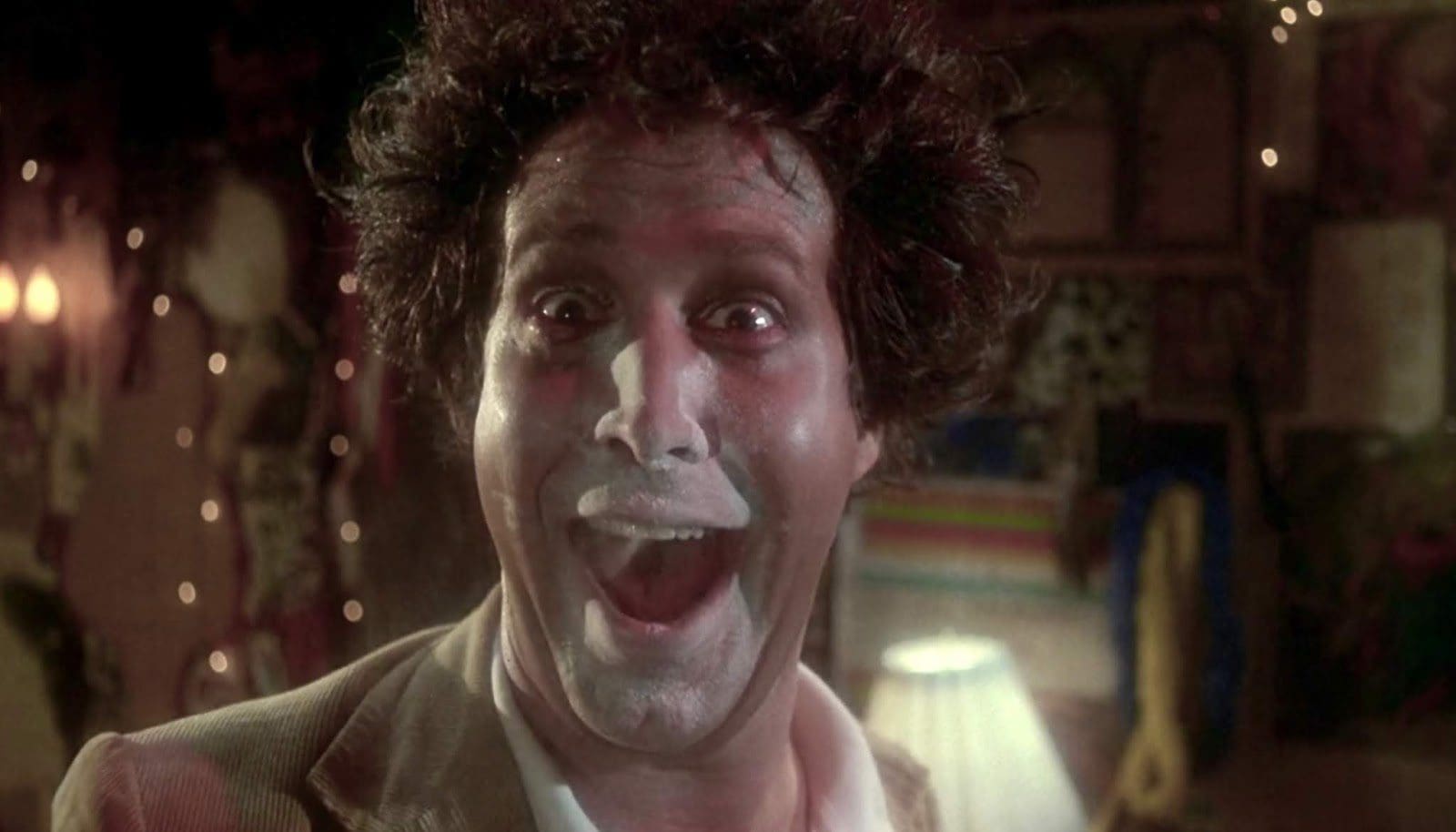
FILMING SEEMS TO HAVE BEEN AN UNPLEASANT EXPERIENCE.
It was the best of times and the worst of times for Chase. Chase's divorce was recently finalized and one of his best friends was dead. And, for the entire duration of filming, he was in litigation with the world's biggest and most admired movie star of all time, Cary Grant, who was suing him for slander after Chase called him a "homo" on the late night talker "The Tomorrow Show." The lawsuit hung over Chase during filming and through Modern Problems release. On the other hand, Chase was in love. He'd met future wife Jayni while filming Under the Rainbow. According to Chase's authorized biography, "I'm Chevy Chase...and You're Not," he and Jayni were so committed to seeing if the relationship would work, they'd decided she wouldn't work while he filmed Modern Problems so they could spend as much time together as possible.
Chase was electrocuted on set. It was Ken Shapiro's fault. For the scene where Max dreams he's an airplane, Chase was to wear "landing" lights on his arms as if they wings. In Chase's biography, it states the special effects and wardrobe team planned to attach the lights on top of his shirt. However, Shapiro disagreed and "thought the lights should be attached directly onto Chevy's skin." While Chase trusted the team, he said he voiced his concerns: "The way I understood it, it was not simply DC power, but AC power too -- something to be of, enough so that I said, 'Look. I'm clammy, sweaty. I hate electricity, electric shocks. I think there's a danger.' No one involved agreed with him. 'It's perfectly safe,' they said. 'Don't worry. We can test it.' The test -- which meant the lights were on him when they applied electricity -- proved that it wasn't safe. "For 10 seconds, I was screaming, as this electric current was going through my body. Screaming, 'Turn it off, turn it off!" They thought he was kidding until his body hit the floor.
Burned on the insides, Chase almost died. He was hospitalized. And traumatized. What he experienced was akin to the electric chair. Grunge believes Chase's near death experience gave him Post-Traumatic Stress Disorder, something less recognized in the 1980s for incidents outside of war. Grunge theorizes this contributed to Chase's drug and alcohol addiction issues.
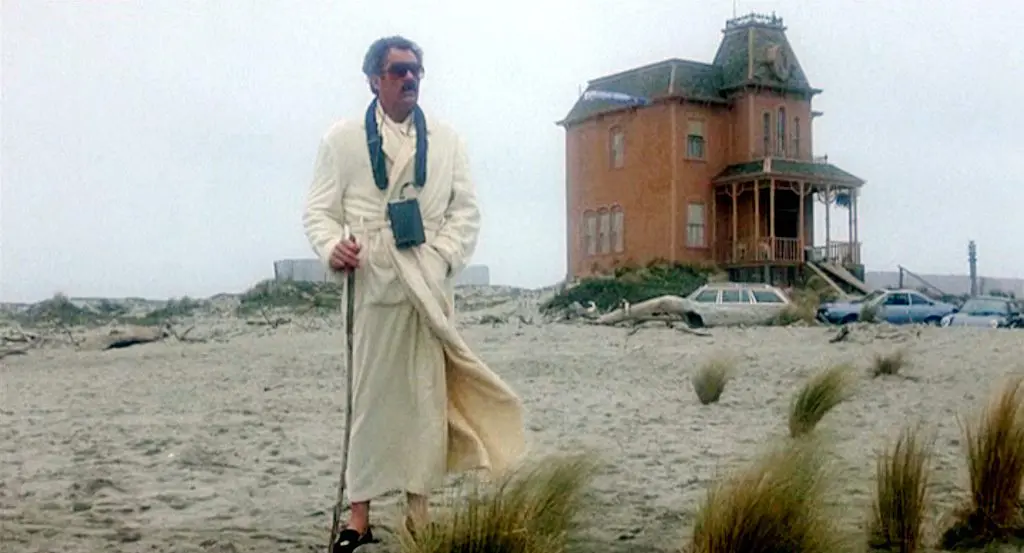
SO LA. SO NEW YORK. SO OXNARD.
The house in the middle of the beach wasn't real. Brian's house in the middle of the beach: that was a little weird, right? Yep. It was. A fake facade of Brian's house was built on the beach in Oxnard, but there was nothing on the inside. But, a real mansion was used for the interiors of the home, as well as sound stages.
Brian's beach house is intended to be a house of horror. It's a replica of the Bates Motel from Alfred Hitchcock's Psycho.
Kennedy Airport was actually used. Choreographer Max Fielder is an air traffic controller at JFK in New York. And, that's where they shot the frames.
NO GOOD REVIEWS
Vincent Canby calculated there was one good laugh every 24 minutes -- and the humor didn't hold up, even then. “Modern Problems relies more than a little on bad taste to keep it going, including jokes about paraplegia, nuclear waste and the insolent black maid who is a voodoo witch," Canby wrote in The New York Times. "Mr. Chase can be funny when he has funny things to do, but his film personality is so bland that he seems to disappear without leaving the screen when he must play a more or less straight scene."
The Washington Post declared, "Chevy Chase will need a miracle to revive his career from the ashes." "Modern Problems is not the work of clever or ingratiating humorists," wrote critic Gary Arnold. "Perhaps there's a director somewhere who could leap from a Disney comedy situation to a De Palma thriller shock and make the stunt seem breathtakingly funny, but Shapiro doesn't have the necessary skill. When "Modern Problems" shifts from sluggish to shocking facetiousness, the only effect you're conscious of is brutal misjudgment.
Toronto's Globe and Mail hung the failure on Chase. Jay Scott wrote, "Any chance the film might have had is trashed at the outset by Chase's disengaged style of non- acting and blasé approach to pants-dropping."
TV Guide tried to accentuate the positive: "Supporting players keep this picture from falling completely flat." With the advantage of having time between release and TV airing, the iconic television publication may have analyzed it best: "The humor is forced, which didn't prevent the film from grossing more than $15 million in its first release.
PRODUCTION AND POST-PRODUCTION TIDBITS
The opening scene is a callback and a nod. The TV show playing in the opening scene is a sketch "Koko the Clown." It's a clip from Shapiro and Chevy's first film, The Groove Tube.
Dabney Coleman's butt makes its on-screen debut. The actor's backside also made its final appearance. Coleman has had a wonderful career, but not as a romantic lead.
Shapiro came up with the film's most honest tagline. "Ken Shapiro The director described it as, "An adult Disney movie...in which Carrie meets Annie Hall."
The MPAA originally gave it an R rating. The studio already had put a marketing campaign assuming it was going to receive a PG rating. The film was cut and rerated.
RELEASE AND LEGACY
A critical failure, a box office success. Despite terrible reviews, the Los Angeles Times declared Modern Problems a winner. It earned more than $26 million during a two month run in theaters. It's the 30th biggest box office earner in 1981, making more money than Reds, Arthur, and Taps.
HBO gave Modern Problems a life well beyond its theatrical run. Now rated PG, it ran during the day. In an era of latch key kids with no afterschool activities or nannies, '80s kids all watched Max uses his telekinesis to pleasure his girlfriend over and over again.
It's often ranked as one of the worst films of all time. As new audiences discover this old film, it's made a lot of lists. Lists lIke, "movies that have aged like milk," "worst Chevy Chase movie," and "worst film score in history." Perhaps the most accurate, though, was "worst movie I liked."
It was nominated for a Stinker Award. While getting a "Dishonourable Mention," Modern Problems did not take the title of Worst Picture. That award went to Tarzan, The Ape Man. And, it didn't get any nominations in the 2nd Annual Raspberry Awards, although Chase's other 1981 film, Under the Rainbow, was nominated for Worst Score.
Indeed, this was a career ender. While Chase continued to make films, Ken Shapiro did not. Modern Problems was his final film. It's likely that studio heads properly assessed that Chase and his co-stars were the reason the film turned a profit, blaming the writer-director known for the bad reviews. And, with Chase unwilling to work with his friend Shapiro after being electrocuted by him, even if they had revolutionized comedy together.
Ken Shapiro abandoned Hollywood. According to Shapiro's obituary in the Los Angeles Times: "Uncomfortable in the corporate structure of studio and TV networks, Shapiro left Hollywood after Modern Problems, eventually settling in Los Cruces, NM.
Soundtrack
The film only features two original songs: "Gonna Get It Next Time" and "She Takes All of Me." Both are written by Dominic Frontiere, known for TV theme songs like Vega$ and eventually the head of Paramount Music). Lyrics are by Adrienne Anderson, known best as a frequent co-writer with Barry Manilow ("Could It Be Magic").
"Gonna Get It Next Time" is performed by The Tubes, arranged by David Foster. The Tubes just came off a very high profile flop: Xanadu. They went on to create more songs for film in the 1980s, including Ladies and Gentleman, The Fabulous Stains and My Science Project. Foster's first work as a composer in filmed entertainment was writing "Look What You Done to Me" for Urban Cowboy, but then worked with The Tubes for their song and music video "Don't Want to Wait Anymore." This collaboration led to Foster's first credit with arranging music for soundtracks. Foster, of course, goes on to compose the theme song to St. Elmo's Fire and a bazillion other songs.
The other song in the film is in the famous ballet scene. The ballet is Coppelia with music written by the 19th century French Romantic composer Léo Delibes.
Director: Ken Shapiro
Screenwriter: Ken Shapiro, Tom Sherohman, Arthur Sellers
Release Date: Dec. 25, 1981
Rating: PG
Opening Weekend Rank: #1
Opening Weekend Box Office: $4.8 million
Lifetime Gross: $26.2 million
Budget: $8 million
Production Company: Three Wheel
Distributor: 20th Century Fox

